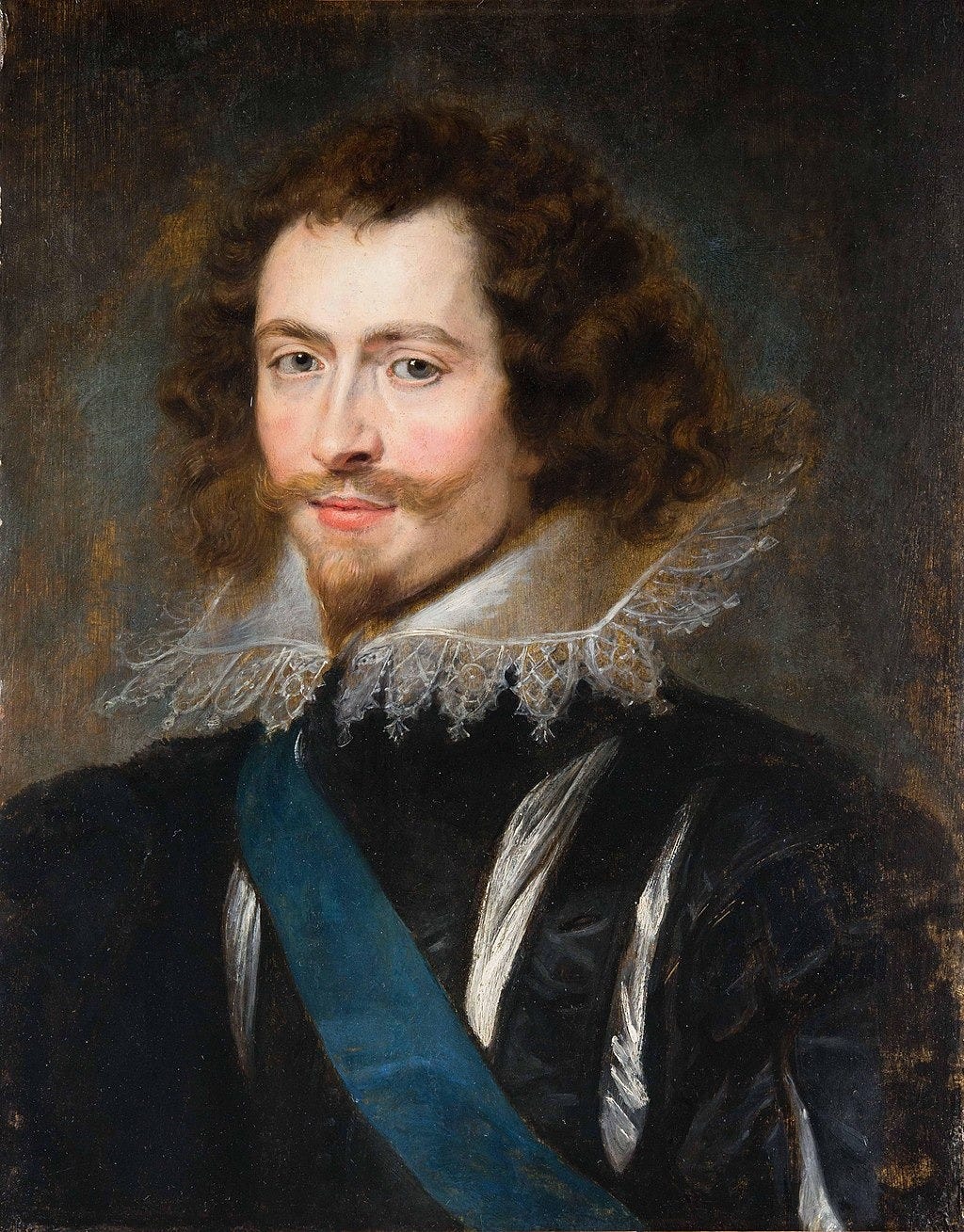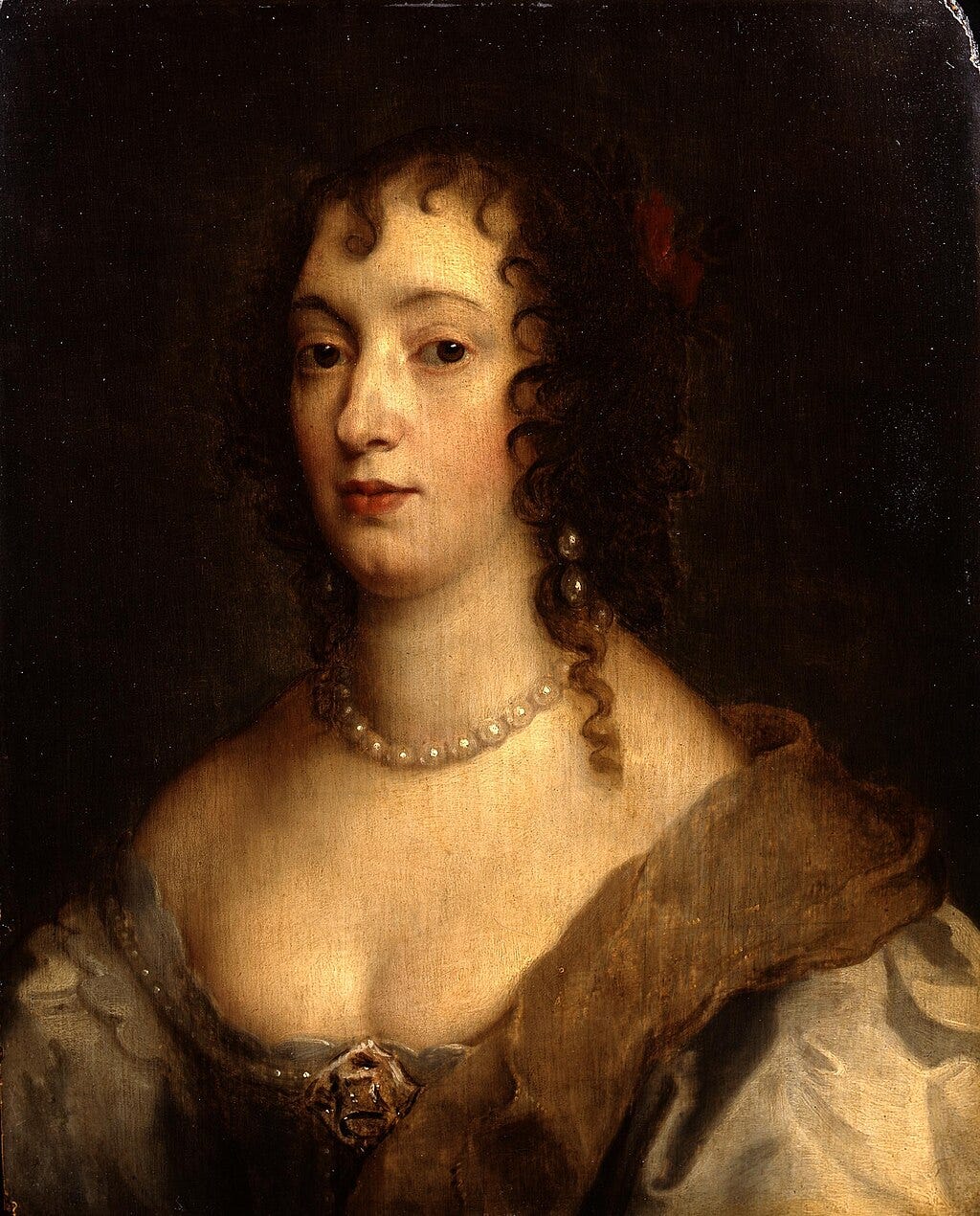Lovers, Heroines and Duchesses, Oh My!
An Introduction to 5 Member of the Villiers Family at the Stuart Court
The Villiers family is an incredibly large family who rose to first local prominence and then national prominence in a big way during the Stuart Dynasty (I will use the term Stuart Dynasty in reference from the time of James VI and I to Queen Anne). Their influence reached far and wide through the dozens of family members that held noble titles and political positions lasting well beyond the 17th century and through to today. For the sake of this small bite of history however, I want to shine a light on a group of descendants of George Villiers.
George Villers was born in 1544 and he was a very prominent figure in the county of Leicestershire. He served as the High Sheriff of the County, a Knight of the Shire and a Member of Parliament. He had two marriages, which resulted in his having several children who also led very fascinating and even more prominent lives than he did. Through his first marriage to Amy Saunders he had two sons and four daughters. Through his second, to his cousin Mary Beaumont, he had three sons and one daughter.
We will actually start by highlighting the children of William Villiers and his second wife, Mary Beaumont. With their son we find perhaps the most prominent member of the Villiers family George Villiers, Duke of Buckingham, as well as his sister, Susan who was a valued member in the household of Queen Henrietta Maria. Their time at court also began before most of the descendants of George’s first marriage, so it makes sense chronologically to start with them.
It has been long suspected that George Villiers, (who was made 1st Duke of Buckingham) was the lover of James VI and I. James was known for having male favorites and it is believed that he had very deep and intimate relationships with these companions. King James first noticed George at a hunt, and, seeing an opportunity to replace the current favorite of the King, many people came together to elevate George by buying him a new wardrobe and having him made Cupbearer to the King. As the King’s affection for him grew, George quickly moved up through the nobility, eventually being made the Duke of Buckingham. It is believed that he was the King’s “greatest love” and many of the letters between the two would also suggest this as the King referred to George by calling hime “Wife” and by his pet name, “Steenie.” It should be noted however that even though he likely was in an intimate relationship with the King, he also had a fruitful and happy marriage to Katherine Manners, a daughter of the Earl of Rutland (now that family are the Dukes of Rutland) and they had four children. George remained very prominent in the court of James’ son, Charles I before his eventual assassination in 1628.
The Duke of Buckingham’s sister, Susan Villiers became the Countess of Denbigh upon her marriage to William Feilding, 1st Earl of Denbigh and was the chief lady in waiting to Henrietta Maria. King Charles was in the process of trying to rid Henrietta Maria’s household of French ladies and replace them with English ones (which would be so incredibly hard after moving to a foreign country). The Queen went to Susan who was able to prevail upon her brother, The Duke of Buckingham, to ask the King if her French nurse would be allowed to stay. As Buckingham was also a favorite of Charles I (though not in the same way as he had been to his father King James) the King agreed and Susan kept her position for the rest of her life. She did eventually actually convert to Catholicism in France which did not go over well in England. Her descendants are still the Earls of Denbigh today.
Back to George’s first marriage, when he had a son named, Sir Edward Villiers. He held several titles including Master of the Mint, Member of Parliament and Lord President of Munster. Sir Edward had several children, through whom descended two very prominent women of the Stuart Court. Through his son William, came his granddaughter Barbra Villiers and through his son Edward came another granddaughter, Elizabeth Villiers.
Barbara Villiers is most famous for being one of the most prominent mistresses of Charles II and mother to at least five (possibly six) of his children. She became Barbra Palmer after her marriage to Richard Palmer, and they were made the Earl and Countess of Castlemaine. Charles II made Richard the Earl of Castlemaine as a way for his illegitimate children to have inheritance as only Richards children “by Barbra” could inherit the titles. As it happened, Richard appeared to not be the father of any of Barbra’s children and the couple separated in 1662 after the birth of her first son by the King. Barbra had three sons who were all given Dukedom’s by Charles II and she also had three daughters. Two of her daughters married into the aristocracy and her third daughter, who was thought to be the child of John Churchill, became a nun. She was made a Lady of the Bedchamber, even thought the Queen did not like her at all (for obvious reasons!) and the King also bestowed titles on her such a Baroness Nonsuch (as she owned the Tudor Era palace) and eventually, he made her Duchess of Cleveland in her own right. She did fall out of favor with the King as, over time, he found a new favorite. However it should noted that The Dukes of Grafton today are direct descendants of Charles II and Barbra through their son Henry Fitzroy 1st Duke of Grafton, and they still carry the name of Fitzroy. (Which means illegitimate child of a King)
Elizabeth Villiers was a first cousin to Barbra as their father’s were brothers. Elizabeth was the daughter of Edward Villiers and Lady Frances Howard. They became prominent at court as her mother, then Lady Villiers was made governess to the daughters of James II and Anne Hyde, the future queens, Mary II and Anne. Her mother’s position helped secure a prominent place for her children at court, and Elizabeth became the mistress of William II. After the death of Mary II, it is believed William ended their relationship, however he did try and settle lands on her, which were later revoked. She went on to marry George Hamilton and he was made the Earl of Orkney. As Countess of Orkney, she founded Midleton College in County Cork, Ireland. She remained prominent into the Hanoverian Era.
Barbra and Elizabeth had an aunt named Anne Villiers who is known for her bravery as a heroine at the Stuart Court. Anne was the daughter of Barbra and Elizabeth’s Grandfather, Sir Edward Villiers and she was married to Robert Douglas, Lord Dalkeith, and later the Earl of Morton. She was the Godmother of Princess Henrietta, the daughter of Charles I and Queen Henrietta Maria. During the Civil War, the infant princess was left in her care as the Queen fled to France. Rather than taking the princess to St. James Palace as she was supposed to, she disguised herself and the princess and fled to safety in France where Henrietta Maria was. She was Praised for her brave actions upon her arrival in France, where she remained as the Governess of the Princess until 1651.
I would like to note, that these two cousins also had a great aunt named Anne who also was connected to one of the most important figures in history, George Washington. Anne was a sister of their grandfather Sir Edward Villiers and she married Sir William Washington. Sir William Washington was the older brother of Lawrence Washington who was the great-great-grandfather of George Washington, The First President of the United States. At the time of their marriage, I bet she never would have guessed that her great several times great nephew would have been the first president of a new country! Through her daughter, the Earls of Dartmouth also descended.
While the short introductions of these few members of the Villiers family barely scratch the surface, I chose them because I wanted to share the wide ranging impact the family had. They were a huge family and became very powerful in large part because of the relationship of the Duke of Buckingham to James I. But, rather than rising to a short lived prominence under one monarch, their impacts were strongly felt through the entire Stuart Dynasty, reaching even to today as many of their direct descendants are still members of the aristocracy. Both the men and women in this family held their own titles, and were as close to the royal family as possible. If you were at all near the Stuart Court, you would have undoubtedly come across a Villiers. It is ironic to think that their family has stood the test of time much farther into the future than the original royal family that they served did!
If you are looking to add a bit more British History into your life, be sure to check out the latest from the MBH paid content where we are currently working through a collection of personal letters from Edward VIII when he was Prince of Wales, to his longtime mistress, Freda Dudley Ward! Here is the most recent post…
An Unnatural Life: Prince Edward Reveals His "Deep Down" Feelings
While on the quest through these fascinating letters, we have come across things about Prince Edward like his opinions, his love for gossip, his feelings for Freda and about his work. Now we are getting to a point where his relationship with Freda clearly deepens and he truly begins to open up. While reading these deeper letters, I actually began to see him in a very different light. See, the generally accepted narrative about Edward VIII was that he was a bit unruly, he wanted to do things his own way, his father said he would ruin himself, and he wanted to marry an American divorcé which ultimately caused him to abdicate the throne. But reading intimate thoughts of Edward’s, it is extremely clear why he is feeling the way he is, and frankly, at this early stage in his life, I think his thoughts are justifiable. No matter what anyone might feel about his actions later in life, (and quite honestly, will anyone ever completely know the whole story?) many of which I personally find to be childish, I am unearthing more and more about Edward that is often left out of his story. I continuously find myself wondering if he had been heard early on in his life, he would have been the popular and dazzling king that so many of his generation thought and hoped he would be. But, when one who is full of ideas and as his wife Wallis said in an interview, “is ahead of his time” which in many ways, he was, it is no shock that the disillusionment with his role would continue to grow each time he was thwarted.
Thank you for reading and supporting my work! I appreciate you all so very much, and I can’t wait to hear which member of the Villiers family your find most interesting!
Until Next Time,
McKenzie









I learned a bit about the Stuarts from a book about royal “poisonings” and this fed my need to learn a little more. Great article!
If anything, George Villiers was a hot guy.